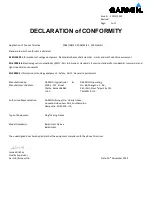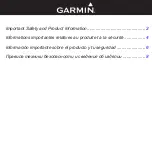
◗
Do not tan a particular part of your body more than once a day. Avoid
excessive exposure to natural sunlight on the same day.
◗
Consult your doctor if ulcers, moles or persistent lumps develop on the
skin.
◗
The appliance is not to be used by people who get sunburnt without
tanning when exposed to the sun, by persons suffering from sunburn, by
children, or by persons who suffer (or have previously suffered) from skin
cancer or who are predisposed to skin cancer.
◗
Always wear the protective eye goggles while tanning to protect your eyes
against excessive doses of ultraviolet, visible light and infrared. (Also refer
to section UV and your health.)
◗
Remove creams, lipstick and other cosmetics well in advance of a tanning
session.
◗
Do not use any quick-tan lotions or creams meant to speed up the
tanning process.
◗
Do not use suncreams or lotions meant to protect your skin against
sunburn.
◗
If your skin should feel taut after the tanning session, you may apply a
moisturising cream.
◗
To acquire an even tan you should lie directly below the lamp units.
◗
Do not choose a tanning distance of less than 65 cm.
◗
Only move the appliance when it is in transport position. Make sure that
the two parts of the appliance have been properly fastened before you
move it. Do not attempt to lift the appliance on your own.
◗
Colours may fade under the influence of the sun.The same effect may
occur when using the appliance.
◗
Do not expect the appliance to yield better results than the natural sun.
UV, tanning and your health
Just as with natural sunlight, the tanning process will take some time.The first
effect will only become visible after a few sessions (see section "UV tanning
sessions: how often, how long?").
Overexposure to ultraviolet (natural sunlight or artificial light from your
solarium) can cause sunburn.
Besides many other factors, such as overexposure to natural sunlight,
incorrect and excessive use of a solarium may increase the risk of skin and
eye problems.The degree to which these effects occur is determined by the
nature, intensity and duration of the radiation on the one hand and the
sensitivity of the person involved on the other hand.
The more the skin and the eyes are exposed to UV, the higher the risk of
keratitis, conjunctivitis, damage to the retina, cataracts, premature skin ageing
and the development of skin tumours will be. Some medications and
cosmetics increase the sensitivity of the skin.
Therefore it is highly important:
B
that you follow the instructions in sections "Important" and "UV
tanningsessions: how often? And how long?";
B
that the tanning distance (distance between the UV filters and the body) is 65
cm.
B
that you do not exceed the maximum amount of tanning hours per year (i.e.
21 hours or 1260 minutes);
B
that you always wear the provided goggles while tanning.
ENGLISH
7
Содержание HB871
Страница 1: ...HB875 871 ...
Страница 2: ......
Страница 4: ......
Страница 109: ......
Страница 110: ...www philips com 4222 002 23792 u ...








































